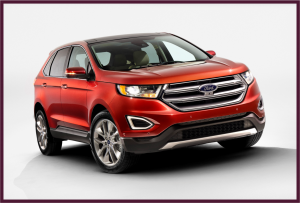
The rear twist beam axle is replaced with a sophisticated multi-link design that allows a wide latitude in tuning for comfort or handling. Edge could give the German automakers some competition. Pricing of course is unknown.
Ford Motor Company today in Dearborn and Cologne showed 2015 model versions of the Edge five-passenger SUV that goes on sale after the first of the year in the U.S. Since its 2006 introduction, the two-box unit-body design that is built in Canada has far, far outsold competitors such as the Honda Crosstour, Nissan Murano and Toyota Venza. Chinese production will undoubtedly be announced. Moreover, Edge in a first will be exported to Europe. With time, Edge will be sold in more than 100 markets.
Globally utility vehicle demand continues to expand, with Ford Motor Company selling a record 1.2 million Utes of various sizes in 2013 – up 38% compared to 2012. Not surprisingly, all major automakers are now crowding into the segments. Part of Ford’s strategy to retain SUV sales leadership is to take the front-wheel and four-wheel drive versions of Edge upscale, with as much technology as can be packaged on its brand new global C/D platform. This looks like a good bet, if Ford can build such an all-new highly complex vehicle without major quality gaffs, a well-known Ford weakness that seems to be improving recently. Whether it can maintain an ‘edge’ remains to be seen.
Edge will be available for the first time with a front camera to help drivers see better, an enhanced active park assist system to enable perpendicular (new) and parallel parking in tight quarters, a glove box-mounted airbag and a trick adaptive steering system (below) to make Edge easier to maneuver and more fun to drive. A premium-level Titanium series will be available for the first time.
In North America, Edge will come standard with a 2-liter EcoBoost engine, tuned – it’s said – to deliver a balanced mix of fuel economy and performance (estimated 245 horsepower and 270 lb.-ft. of torque). A yester-tech normally aspirated, 3.5-liter V6 engine will also be available. The Sport model have a 2.7-liter V6 (est +300 hp), along with standard 21-inch wheels, the highest-performance Edge. No EPA ratings and no prices were released.
All three engines are mated to Ford’s SelectShift six-speed automatic transmission with paddle-shift activation. Drivers will have the ability to select gears manually via paddles on the steering wheel. The paddle-shift system is standard on all models.
The SelectShift transmission features two modes of operation – drive and sport. Sport mode offers a more aggressive shift pattern, allowing the engine to rev higher during acceleration, and hold lower gears longer to support spirited, fast-paced sessions.
Unlike many paddle-shift systems, the Edge six-speed automatic is always “live in drive,” so the driver will not have to select sport mode to enable operation.
The option list is formidable. Auto Start-Stop can improve fuel economy by turning off the engine when it is not needed, such as when the vehicle is stopped at a traffic light. Other technologies include Ford’s hands-free liftgate, SYNC with MyFord Touch, adaptive cruise control and inflatable rear safety belts. A heated steering wheel, along with heated and cooled front seats will be optional as well.
Standard on Edge Sport and optional on the Titanium series, is adaptive steering that changes the ratio between a driver’s actions at the steering wheel – the number of turns – and how much the front wheels respond. In traditional steering systems, this is a fixed steering ratio. With Ford adaptive steering, the steering ratio continually changes with vehicle speed, optimizing steering response in all situations.
At lower speeds, such as pulling into a parking space or maneuvering in tight quarters, the new system makes the vehicle more agile and easier to turn, as it dials more steering angle into the road wheel. Each low-speed maneuver requires less turning of the steering wheel.
At highway speeds, the system further optimizes steering response, enabling Edge to react more smoothly and precisely to driver input.
The Ford system uses an actuator placed inside the steering wheel, and requires no change to the vehicle’s traditional steering system. The actuator – an electric motor and gearing system – can essentially add to or subtract from a driver’s steering inputs.


